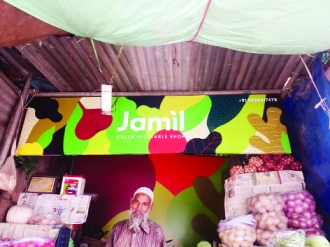Festival director of Indianama, Kunel Gaur on assessing India from a new vantage point.
Indian streets are fascinating spaces, where myriad colours come together daily. To the Indian eye, this is mostly invisible because we are used to it and consider it commonplace. The kirana shop is part of that colourful space but often goes overlooked. The Indianama 2018 festival will bring together 71 graphic designers to redesign 71 vibrant street side shops marking the 71 years of India’s Independence. Each designer was paired with a shop/business owner to conceptualise, design and initiate an identity system for them. This identity system was implemented on-site, with due supervision by the designer, if and when required. A packaged version of the project will be unveiled at the Bikaner House featuring shops and local businesses from Karol Bagh, Saket, Mehrauli, Saidulajab, Chandni Chowk, Jama Masjid, Chawri Bazaar and more.
India is diverse and mostly divergent. Why do you call India schizophrenic?
Schizophrenic here refers to the dynamic, almost hallucinative visual culture we live in. It doesn’t refer to the country as a whole, but a part of it. One that is so rich it appears to be of another world, at another time, in another universe.
Why did you decide to do up storefronts and why do they need an identity system?
In India, just as much as our malls and high streets stand out, our markets with their vendors blend themselves in our daily lives to an extent of being inseparable. Still, design never managed to reach the streets, never became a part of the charming culture that street markets are all about. Hence, to truly transform the way India sees design, through this edition of Indianama we’re taking design to India’s original showplace. We want to give access of good design to people who’ve never known what it can do for them
In the designers’ reimagining of India, what is the core sensibility that they have to keep in mind?
The selected designers were picked based on how much their work related to the concept this year. And whether a particular business fit the design sensibilities of those we shortlisted. We had to make sure that the kind of work they have done in the past resonates with the business/store/ small shop they have chosen to work on. This was important considering the challenges we could face at the time of implementation.
What revelation, if any, emerged from last year’s Indianama?
Last year’s Indianama focussed on visualising the different sides of India from the point of view of a tourist visiting India.
We went in expecting that most of the artwork will follow a template, a blueprint of how the larger world sees India (it’s usually busy streets and bright colours.) We were happy to be proven wrong. In fact, it was a pleasant surprise to see all shades of the country represented, ranging from billionaires’ castles looming above a grocery store to a tribute to a decade full of disco — it was quite the wild ride.
In this modern re-envisioning of the kirana shop, what did the designers find in common across the city?
Chaos, and confusion, and sudden love for colours. Reluctance that turned into enthusiasm the moment we revealed the first draft of designs to the shop owners.
Is the exhibition a reminder for the country to step back and evaluate its core?
As a country, we treat design as a medium of marketing, a way of presentation that’s bound to get your attention. While this helps corporations and startups that work with creative agencies like us, empowering them with great design systems, there’s a whole other side of it that is completely ignored. The exhibit is a reminder to stop and evaluate our sensibilities, and the role of design in making a difference by helping those that least understand it.
Do art exhibitions for design grab enough attention and are they the right platform for the country’s artists?
Exhibits like these create better environments for locals to come and experience design, or any form of expression in the sense that it will used eventually. The 2018 edition is a step back in terms of technology and use of digital media, but a step forward in the direction that we intend the local Indian design scene to move to.
Where is the Indian design sensibility headed?
On the timeline of where we’re coming from and where we’re headed, we’d call it the post re-interpretation phase. We’re contemporising our heritage and culture — giving birth to new vantage points that show different sides of India to everyone looking over — as opposed to one universal definition of India as a heritage state.
Writer: Asmita Sarkar
Courtesy: The Pioneer








 OpinionExpress.In
OpinionExpress.In















Comments (0)